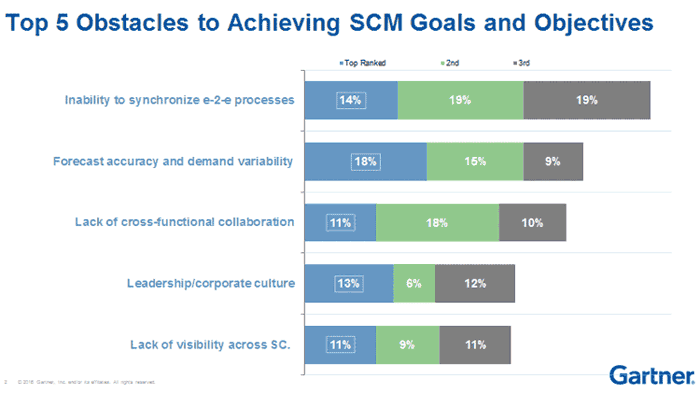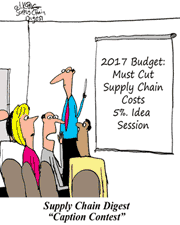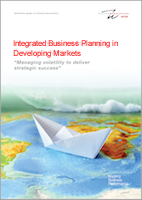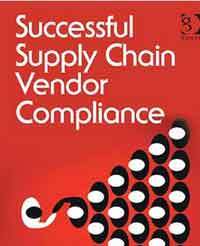 |
December 8, 2016 - Supply Chain Flagship Newsletter |
 |
| FEATURED SPONSOR: 10TH ANNUAL GARTNER SURVEY |
|||
It's Back! 10th Annual Gartner-SCDigest Supply Chain Study!
|
|||
As Always, Survey Respondents Receive Complimentary |
|||
 |
|
|||||||||||||||||||||||||||||||||||||||||||||||||||||||||||||||||||||||||||||||||||||||||||||||||||
All that said, I offer again our Audience Bill of Rights, which provides some reasonable guidelines for what you should expect and demand from presenters. We have even heard of conferences where organizers are now using some version of this document in communicating with speakers. The only major events I didn't get to were the Institute for Supply Management conference, which as always directly overlapped the WERC event and Gartner conference, and APICS, which I just haven't made it to for a number of years.
I delivered one of our popular trip reports on I believe every one of those events this year in one form or another, including many video summaries. If I was at your event and have somehow failed to mention it, please let me know. My sense frankly is that overall the quality of presentations has been trending down: lots of good ones, but fewer great ones, for reasons not clear. We also lack a strong cadre of recognized supply chain thought leaders, as is common in other disciplines. So now as always, in random order, is my list of the best presentations I saw in 2016, capped by SCDigest's runner-up and best presentation of the year awards. As far as I know, all those cited are still at the companies they were with at the time of their presentations, but of course that could have changed. Also, with the trend at many conferences towards more panel discussions versus presentations, I have for the first time this year included a few outstanding panelists in my 2016 list. Rob Coyle of GlaxoSmithKline on "elevating the role of outsourced logistics" at the Gartner conference. What do you do when you realize logistics is not really a core competence at your company? Coyle discussed GSK's path very effectively, including a very interesting approach to achieving complete transparency when using a lead logistics provider.
Paul Bjornsson of IKEA at the JDA user conference, with a very good presentation on the retailer's development of a capacity management system for its 1000 suppliers. He started with some interesting questions, such as how do you really define capacity? What are the metrics or units of measure? I have not heard of anyone else implementing a system such as IKEA has built in this area.
Steve Reade of shoe retailer DSW, on a panel on distribution trends at CSCMP. I had not heard of Reade, but he was very insightful, from comments on the need to really spend time on the human-equipment "interface' when automating DC operations to the need for companies and vendors to start thinking more holistically about product flow across the DC, not just what happens in individual processing areas.
Sven Verstrepen, of Belgian logistics services provider Ahlers, for a presentation at WERC on so-called "horizontal" logistics collaboration, meaning efforts between complementary shippers, maybe even competitors. I have seen Verstrepen speak on this in the past, but it keeps getting better, and reflects what I believe is a coming megatrend, driven as much by sustainability as it is cost savings.
Brian Streu of Whirlpool did an excellent job of describing the appliance giant's evolution in developing supply chain network design as a core competence and something used on a continuous basis, on an SCDigest videocast this summer along with Toby Brzoznowski of LLamasoft. "From project to process" was the theme. Very good. Cristian Negrescu of Mondelez and Mike Burnette of the University of Tennessee (formerly of Procter & Gamble), on "platform thinking" in the consumer packaged goods supply chain, at the Tennessee forum. At the core of platform management in CPG is supply chain simplification, achieved through SKU rationalization and standardization of packaging, formulas, processes and equipment across the globe. Can drive huge savings, but few doing it well today.
Mani Janakiran of Intel at CSCMP on the company's incredible use of advanced supply chain analytics. What Intel is doing with analytics today is already mind-blowing, such as a a "supply-demand solver" that looks out over some horizon, and not only identifies where there is a gap in S&OP plans, but also suggests how the issues might be best resolved. Intel has really modeled its entire supply chain, layering truly advanced and innovative analytics on top of that.
Frank Crespo of Caterpillar in a wide ranging keynote presentation at the Gartner conference, which included one of the better discussions of how the Internet of Things can be used in supply chain that I have seen. Caterpillar monitors its expensive machines out in the field through IoT, recognizing that "Every decision an operator makes impacts time and money," Crespo said.
2016 Runner-Up: Sascha Krall, Andreas Mätzler and Pascal Verschueren of chip maker Infineon, at the JDA user conference. Notable for describing how the company boldly realized it couldn't accurately forecast demand very far out, and that the best path was to lay out detailed scenarios for execs to choose from in making investment decisions, and for detail on the "cube" Infineon has built for Integrated Business Planning that completely links demand, supply and finance. Make a change in one area, and the effects instantly ripple through the others. And the winner for 2016 is Piyush Bharkava, a procurement executive at Dell, who presented at CSCMP on the company's remarkable development of an innovation culture to support its sustainability efforts. Bharkava started out a bit of a sustainability skeptic, but has been converted, detailing the many creative ways Dell encourages innovation that helps it achieve sustainability goals - while reducing supply chain costs $200 million annually. 2015: Sean Willems, chief scientist at Logility and also of the University of Tennessee, on the "efficient frontier," basically a fresh look at supply chain tradeoff curves. 2014: Bill Nienburg, VP of Global Merchandise & Sales Planning at Under Armour, for an in your face description of how the apparel giant was going to use supply chain to win in the market - and he really meant it. 2013: Richard Murphy, CEO of Murphy's Warehouse Co., at the WERC conference, on the business case for Green investment in distribution. Great, practical detail. 2012: Raj Subramonian of Dell, with an outstanding, heartfelt presentation at CSCMP on use of "vested outsourcing" to transform a stale 3PL relationship. 2011: Rudi van Schoor, of SABMiller's South African operations at the SAPICS conference there, on stopping a major supply chain planning project in mid-stream and totally and successfully re-orienting the approach. 2010: Chris Gaffney of Coca-Cola, at Georgia Tech on how to bring balance into increasingly challenging supply chain careers, and how with the right formula less can really be more for both managers and the company. 2009: Jim Kellso of Intel at CSCMP, on rethinking Intel's supply chain to work for a new chip whose much lower price point required a dramatically lower cost supply chain. 2008: Matt Salmonson of Old Navy/The Gap stores group, who spoke at an i2 user conference on how to implement software the right way, and make change management happen. 2007: Michael Schofer of Coats North America at i2, describing his company's supply chain transformation as its traditional apparel sector customers were all leaving the US, enabling it to survive. 2006: Paul Mathews of The Limited Brands for his speech on aligning supply chain and the corporate boardroom at the North American Material Handling Show. This was motivational. 2005: Glenn Wegryn of Procter & Gamble, who presented at CSCMP 2005 on how P&G has developed a methodology and set of tools to drive supply chain strategy and planning into overall business strategy and planning - wonderful. I ran into Wegryn at an event in 2014 - he happily referenced his inaugural award! So, that's our list. Congratulations to the winners. There was a lot I missed of course. I welcome your nominees for any outstanding presentations you had a chance to see in 2016. Many ask if I have copies or links to these presentations, and alas I usually do not, but feel free to inquire, as I sometimes do.
|
||||||||||||||||||||||||||||||||||||||||||||||||||||||||||||||||||||||||||||||||||||||||||||||||||||
|
||||||||||||||||||||||||||||||||||||||||||||||||||||||||||||||||||||||||||||||||||||||||||||||||||||
|
||||||||||||||||||||||||||||||||||||||||||||||||||||||||||||||||||||||||||||||||||||||||||||||||||||
|
|
|
YOUR FEEDBACK
Now posting most of the many emails we received on Dan Gilmore's somewhat controversial First Thoughts column on An Inflection Point in the Consumer Goods to Retail Supply Chain?, which discussed what seems to be an emerging trend by retailers to finally address rampant supply chain variability.
Feedback on Reducing Retail Supply Chain Variability
![]()
Your point on the "Bullwhip effect" is well made and I would expand on it by saying that all variability has an inherently inbuilt multiplier effect.
It is not just that but in addition there is the variability exacerbated by the time lags inevitably involved in information getting through. I also believe that data quality is a major cause of the problem. Not just in bad numbers but we simply do not define with sufficient accuracy what we mean by lead time, and other key indicators of performance so that we actually collect meaningful and accurate data.
I challenge that when parameters are set for ordering systems whether sufficient statistical analysis is undertaken of the data being used, or, for example, whether the worst case scenario is preferred when setting lead times.
Lastly we have a tendency not to let systems work their way through the analysis - we intervene, albeit with the best of intentions.
David MacLeod
Learn Logistics Limited

![]()
Retailers have lived with variability for so long because it has been cushioned by lower and lower sourcing costs. Short lifecycle, or fashion, retail is high markup/high markdown, resulting in low single digit profitability and volatility. That must change because there is no lower cost option – no new China – and because speed and flexibility are now imperative to serve customers and to be competitive. This is playing itself out in front pages as "see now/buy now," executive changes and sector investment. For taste-makers, time-to-market is now their highest vulnerability, and they are no longer able to protect their exclusiveness of style, price and profitability by merchandising alone. It is a crisis in trend-driven short lifecycle products, and that is more than simply fast fashion. Industry transformation is upon us.
Warren Hausman of Stanford University and I analyze industry change with what we call the "Zara Gap," as in opportunity gap. It is a measure of supply flexibility tied to market cap and it is a dramatic tale of competition, performance and potential. We also co-authored a related case study, now taught at Stanford. Citi Research is joining us to globalize the "Zara Gap" metrics (forthcoming), and one of America's foremost retailers is implementing the roadmap.
There is much more to say, but I am writing to encourage your commentary. You are quite right to pick up a "sea change" in retail supply chain practices - and opportunity.
John Thornbeck
Change Capital

![]()
Very interesting article especially since I've been on both the "supply side" (major consumer goods companies), and the "customer side" (national specialty retail), and there is definitely a difference in how businesses execute their plans.
In 1997 (almost 20 years ago), after 20 years in consumer goods focused on optimization of the supply side to lower costs, I realized the significant differences between a consumer chain and a supply chain. With over 1400 retail stores (grew to 1600), and limited backroom space, our focus shifted to reducing inventory, improving flexibility of production operations, and strengthening relations with suppliers. Supply chains look backward in the chain while retailer look forward. One focuses on costs while the other is entirely focused on revenue.
By working with the merchandising team, the supply siders became consumer driven and paid little attention to forecasts and began to understand sales build rates under different promotions along with seasonal selling. As technology changes and consumers look for more personalized shopping experiences with instant access to competitive product information, pricing, and coupons, the "supply chain" becomes a heavy burden and slow to move. For "one-time" purchases of promotional or seasonal products, exit strategies were developed before the first product shipped - result was significantly less markdowns. For all other products, production strategies were developed around reduced inventory, responsiveness to sales, and changes in promotional strategy. Every Monday evening, we reviewed sales performance for the prior week, especially promotional plans. If a decision was made to change a plan across all stores, a new plan was developed and reviewed by Wednesday morning and supporting products on the way as early as Wednesday evening.
Depending upon store location, products arrive between Thursday and Saturday of the same week, while stores changed floorsets in preparation of new product arriving. The new plans were implemented on Saturday. A lost sale at retail, whether for an out-of-stock or a promotion not working perhaps due to a competitor program, results in significantly lost margin than the supply chain could ever achieve due to efficiency or negotiated pricing. With over 2000 SKU's on shelf, and because the ‘supply chain' for the retail side focused on daily unit movement across all stores while suppliers focused entirely on responsiveness to inventory changes, the business was able to reduce total inventory by tens of millions of dollars while simultaneously improving in-stock rates to 99.1% measured every Monday morning. And there were no chargebacks to vendors.
Revenue increases when a business has more customers. As you suggest, it's time to focus on the 'right thing.'
Thanks for letting me comment. I look forward to more of your articles.
Joe Roy
Principal, Starfish Consulting Group

![]()
Great perspective on this topic. I do however find the following statement hard to believe and would love to see more info on it: "By the way, the on-time improvement has enabled Target to reduce out of stocks at its stores by more than 50% in the past six months or so."
Mike O'Reilly
Customer Supply Chains
Perrigo
Editor's Note:
That statement was made by Target's COO during its Q2 earnings call, but more correctly was referring to on-line inventories in their DCs, not in-store OOS's.
Dan Gilmore

![]()
I work in the grocery world and all of this stuff that the retailers are trying to do don't seem to have been very successful.
Walmart planning system upgrade turns out to be a giant step backwards in time.
Walmart does a lot of good things but when they make a mistakes they try to over compensate to make it work.
For Walmart, there was more stem reliability and predictability in their old planning system.
Walmart still is the best in grocery planning but they are not as good as they used to be.
Thanks for you weekly communication.
Name withheld by request
Consumer Products Company

![]()
Good article.
Indeed I am experiencing what you describe in your article. What you might choose to mention in the future is that there are step-function increases in supply chain cost for the manufacturer as the retailers supply chain expectations rise. Not so much from on-time being reduced from 4 days to 2 days, but when it becomes +/- 30 minutes, as some retailers already are, then additional costs are incurred by the manufacturer for special transportation services. Intermodal becomes impractical, LTL impossible and then everyone is forced into truckload or 3PL consolidators with standing appointments, milk runs with conservative transit times and lots of costs, again being paid by the manufacturer.
Ultimately the efficiency gained in one part of the supply chain is lost in another and ultimately paid for by the consumer. The bad news for the 600 lb. gorilla retailers is that they are increasingly treating their suppliers badly and the suppliers will look for alternatives such as supply chain efficiency pricing brackets, focusing on growth with better behaving retailers and various ecommerce options.
Dave Perry
Strategic Project Manager
Global Supply Chain Design & Policy
Clorox

SUPPLY CHAIN TRIVIA ANSWER
Q: How many parcels will UPS ship globally this year from Thanksgiving through Dec. 31st?
A: 700 million, according to company estimates, up from 612 million in 2015. The peak day should surpass 40 million packages. Last year, the peak day was Dec. 21.
| © SupplyChainDigest™ 2003-2016. All Rights Reserved. SupplyChainDigest PO Box 714 Springboro, Ohio 45066 |
POWERED BY: XDIMENSION
|








